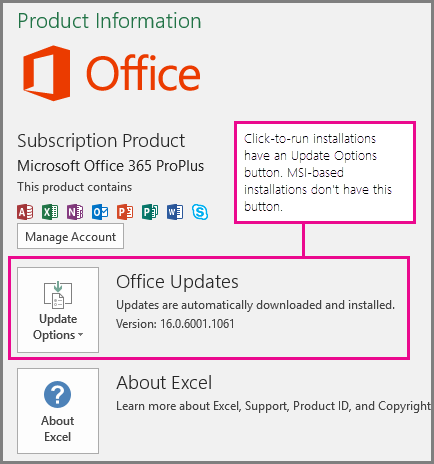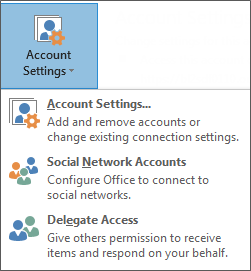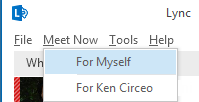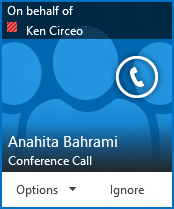Presence statuses include Available, Busy, Away, and Do Not Disturb. Your status is based on your Microsoft Outlook Calendar, if you use Outlook, or your Lync activities. For example, if you have a meeting currently scheduled in Outlook, your status appears as "In a meeting" in Lync. When you're in a Lync audio or video call, your presence indicator appears red, as Busy, and your status is updated to "In a call." But you can also manually set your presence status to control how or whether you want people to get in touch with you. And, your presence can also include a personal note that appears in your Contacts list and on your contact card. This gives people more information about what you're up to.
Change your presence status
-
Click the status menu drop-down arrow below your name on the Lync main window, and then click the status you want to show other people.
To revert from the status you set and have Lync automatically update your status, click the status menu and then click Reset Status.
Choose the appropriate status
Make sure you set your status accurately. The table below describes each presence status that other people may see for you, what each status means, and which ones you can set yourself.
Tip: The presence statuses are pre-set in Lync, which means you can't create a custom status, but you can give your contacts more details about where you are or what you're doing by adding a personal note. See the next section for details.
| Presence Status | Description | How this status gets set |
| | You're online and available to contact. | Lync sets this status when it detects you're using your computer. You can also set this status when you want others to know you're in your office even though the computer is idle. |
| | You're busy and don't want to be interrupted. | Lync sets this status when, according to your Outlook Calendar, if you use Outlook, you have an appointment. You can also select this status from the drop-down arrow. If you do manually set Lync to Busy, it will revert back to your Outlook Calendar status in 24 hours, if you do not change it before then. |
| | You're in a Lync call (a two-way audio call) and don't want to be disturbed. | Lync sets this status when it detects that you're in a Lync call. |
| | You're in a meeting and don't want to be disturbed. | Lync sets this status when it detects that you're in a Lync Meeting or when you're scheduled to be in a meeting according to your Outlook calendar, if you use Outlook. |
| | You're in a Lync conference call (a Lync Meeting with audio) and don't want to be disturbed. | Lync sets this status when it detects that you're participating in a Lync conference call. |
| | You're giving a presentation and can't be disturbed. | Lync sets this status when it detects that you're either sharing your screen or projecting. |
| | You don't want to be disturbed and will see conversation notifications only if sent by someone in your Workgroup. | You select this status from the drop-down arrow. If you do manually set Lync to Do not disturb, it will revert back to your Outlook Calendar status in 24 hours, if you do not change your status before then. |
| | You're stepping away from the computer for a few moments. | You select this status from the drop-down arrow. |
| | You're logged on but your computer has been idle, or you've been away from your computer for a specified (set by you) period of time. | Lync sets your status to "inactive" when your computer's been idle for five minutes, and to "away" when your status has been inactive for five minutes. (To change these default values, click the Options |
| | You're not working and not available to be contacted. | You select this status from the drop-down arrow. |
| | You're not signed in. You'll appear as Offline to people whom you've blocked from seeing your presence. | Lync sets this status when you log off your computer. |
| | Your presence isn't known. | This status may appear to contacts who are not using Lync as their instant messaging program. |
Note: If you use Outlook and you turn on the out-of-office notification, the note you write in Outlook displays in Lync as well, and a red star or asterisk (*) appears next to your presence status at bottom of your picture display area.
Add or remove a personal note
Type a personal note, such as "Working from home," at the top of your Lync main window, to share current details about your status. The note will appear with your contact card. Change the note as often as you like.
To add a personal note
-
In the Lync main window, click the note box above your name, and then type a note, such as "Working from home" or "Working on a deadline, please IM instead of stopping by."
To remove your personal note
-
Click the note box above your name, and, on your keyboard, press BackSpace, and then press Enter. The text in the box reverts to the default message, "What's happening today?"
Turn your out-of-office notification on or off
If your Lync account is synchronized to your Outlook calendar, an out-of-office message displays as your personal note in Lync whenever you turn on the out-of-office notification in Outlook. So, for example, when you're going to be on vacation, you might set up your out-of-office notification in Outlook indicating that you're on vacation (and sharing any relevant information, such as whether you'll be checking email and who your backup is). This notification is published in your contact card and other contact listings that are displayed to your contacts in Lync.
Important: When you return from vacation, remember to turn off the out-of-office notification. You have to go into Outlook to do this. You can't delete the note from Lync.
To turn on the notification in Outlook
-
In Outlook, click the File tab, click the Automatic Replies button, click Send automatic replies, and then write your out-of-office message and schedule it for display.
To turn off the notification in Outlook and thereby remove the message from your Lync display
-
In Outlook, click the File tab, and then click the Turn off button in the Automatic Replies panel. (It can take up to thirty minutes for the note to disappear from your Lync display.)
To sync your Lync and Outlook accounts
-
In the Lync main window, click the Options button.
-
In Lync - Options, click Personal.
-
Select the Update my presence based on my calendar information check box.
-
Select the Display my Out of Office information to contacts in my Friends and Family, Workgroup, and Colleagues privacy relationships check box to sync your Lync and Outlook accounts.
 Available
Available Busy
Busy Presenting
Presenting Be Right Back
Be Right Back button , click Status, and then click the arrows next to Show me as Inactive when my status has been idle for this many minutes and Show me as Away when my status has been Inactive for this many minutes.) You can also select this status from the drop-down arrow.
button , click Status, and then click the arrows next to Show me as Inactive when my status has been idle for this many minutes and Show me as Away when my status has been Inactive for this many minutes.) You can also select this status from the drop-down arrow. Offline
Offline Unknown
Unknown

 for Windows,
for Windows,  for Mac) to see the list of available tracks, captions, or subtitles, and then click the name of one you want to use.
for Mac) to see the list of available tracks, captions, or subtitles, and then click the name of one you want to use.








 Screen reader content
Screen reader content